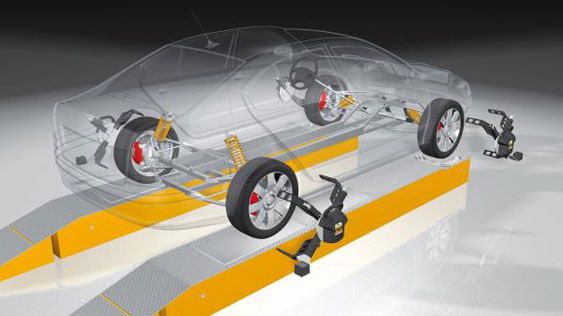Wheel Alignment

Good handling of your loyal four-wheeler is, of course, the greatest priority when it comes to safety and road comfort. Not only do you drive more comfortably in your car, but it also has an important influence on the road handling and safety on the road. A car that does not ' on track' properly requires much more effort to drive and can be a great danger on the road in a moment of inattention. The car pulls to one side, and you can lose control of the steering wheel. So let's align when the first symptoms start to occur.
How do I know that my car needs to be aligned?
That is very simple to determine: choose a road surface that is completely horizontal in width. Very important because most roads have a slight angle towards the sidewalk to ensure that water is drained off the road very quickly. When you drive on such a road, it happens that the steering wheel will pull on one side although there is nothing wrong with the chassis.
After you have found a perfectly flat piece on the road, you simply drive straight ahead and then let go of the steering wheel for a moment. You will notice that the car on one side will begin to stray from the road axis and go to the side. If this is the case, it is time to come to your CTS Auto Centre workshop in Worcester to have the chassis aligned.
Apart from pulling to one side, you will also notice that something is wrong because the front tyres will not wear evenly. It is very common that the tyres will wear out on the inside more than on the outside. Not only is a misaligned chassis dangerous to drive with, but it also causes extra costs due to having to replace tyres more frequently.
How is the alignment done?
The most important thing when aligning is to be able to measure how large the deviation is and how large the correction should be. At our CTS Auto Centre workshop, this is done with advanced technology and the best equipment.
Every vehicle manufacturer comes with the specifications that the chassis has to meet and this is only ready to play by using the right equipment. By using lasers, the deviation is determined after which corrections can be made by adjusting the adjustment screws of the control device.
Glossary:
Camber
The so-called Camber-angle means the difference (measured in degrees) between the wheel’s vertical wheel-alignment, perpendicularly to the road surface.
A perfectly aligned wheel perpendicular to the surface would be at a 0 ° Camber.
A negative Camber = top of the tyres tilt inwards.
A positive Camber = the tyre’s tops are tilting away from the vehicle
Caster = the angle caused by the steering’s pivot point (front to back of the car).
Positive Caster = line is at a forward angle,
Negative Caster = backward angle.
A caster that is positive makes a car more stable especially while driving fast.
Toe
Toe = angle the tyres are pointing to. It’s like looking down on your own feet.
Like the toes are pointing towards each other or away from each other tyres can point towards- or away from each other “toe-in/toe-out”.
The precise toe is crucial when it comes to even tyre wear and material life.
If you have any questions, need more detailed advice or would like to make a booking, please get in touch with us.
Wheel alignment – Worcester – CTS Auto Centre






